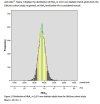No idea where do I find that
Normally, when you're diagnosed, it's done via an HbA1c test. It's just about the only way T2 diabetes is diagnosed in the UK these days.
Your HbA1c result will be on your medical records.It's normally given in millimole per mole (mmol/mol) units, although there's an older system that uses percentages and is still in use in the USA. The chart shows these - you can't really read across from the HbA1c to the mg/dl or the mmol/l that are used for fingerprick tests. They measure different things in different ways.
Most people are told what their HbA1c result is - it's a count of the number of red blood cells that have had a glucose molecule attached, and it gives a fairly good estimate of what your blood glucose levels have been like over the last 2-3 months (which is how long red blood cells live).
Normal values for HbA1c for almost all non-diabetic people run from 35 to 41. Most non-diabetic people have an HbA1c of around 38 (see the graph). If your BG goes out of normal range - ie 42 and up - this has been given the name "pre-diabetes", but it's already an indication that your BG is no longer normal. If BG reaches 48mmol/mol, you will automatically be diagnosed as being T2. There's nothing to stop anyone being diagnosed earlier, but that doesn't seem to happen anymore in the UK.
HbA1c is normally tested every six months to a year and is how the system tracks "how well you're managing". It will be used as the basis for all sorts of decisions eg about medication and dosing, so it's always a good idea to know what your HbA1c is.


